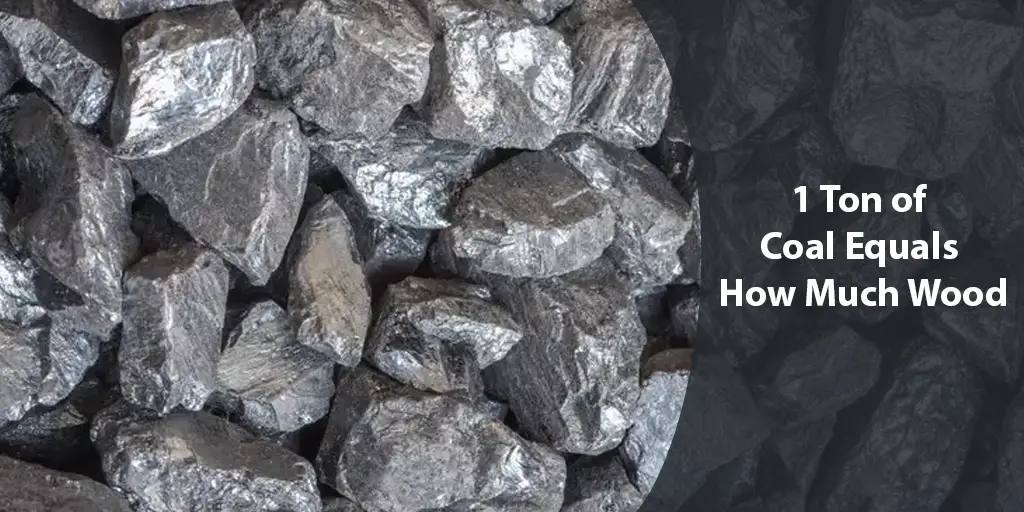Understanding the energy content of different fuels is essential for making informed choices about our energy needs.
In this comprehensive guide, we will explore the energy equivalence of one ton of coal compared to an equivalent amount of fuelwood.

Coal and wood have served as primary energy sources powering civilization for centuries. While coal emerged as a high-density fossil fuel driving industrialization, wood remained the traditional biomass option available in most regions.
Today, the debate around transitioning to renewable and sustainable energy sources puts these two fuels in perspective.
We will start with a brief overview of how coal and wood were historically used before the Industrial Revolution.
Then, we will define the key unit of measurement – British Thermal Unit (BTU) – used globally to quantify energy potentials.
Using scientific calculations based on typical BTU values, we will determine precisely how much wood corresponds to one ton of coal in terms of delivered energy.
The analysis delves deeper into efficiencies of coal and wood combustion technologies. We examine real-world implications through country-based case studies and global trends.
Finally, the environmental and sustainability dimensions are brought to the forefront, with a perspective on evolving future energy preferences.
By presenting all details in a logical flow supported by data and examples, this report aims to impart objective knowledge on the energy equivalence of coal versus wood.
Armed with these insights, readers can evaluate fossil and renewable options based on their multiple technical and strategic merits. Let us begin our comprehensive study.
Historical Context
To fully appreciate the energy equivalence of coal and wood, we must first understand their respective historical roots as primary fuel sources for humanity.
Coal has been used sporadically as a heat source since ancient times, but its widespread adoption didn’t occur until the late Middle Ages in England.
The advent of steam power in the late 1700s truly heralded the age of coal, driving the Industrial Revolution across Europe and North America.
By the 19th century, coal fueled factories, railroads and ships worldwide in an unprecedented explosion of industrial activity.
Wood remained the dominant biomass option for millennia before coal. Prehistoric humans relied on wooden tiki torches and campfires.
Ancient cultures built entire civilizations fueled by wood for tasks like metalworking and pottery firing. Even as coal use accelerated industrialization, wood remained vital for domestic heating and cooking well into the 20th century in many regions.
In tandem with population growth, dwindling forest reserves led to increased forest management and fuelwood plantations by the 1800s. Meanwhile, coal mines were extracting 300 million tons per year globally to meet the colossal energy needs of mechanized society.
Energy measurement
To understand the energy content comparison between coal and wood, we must first define the standard unit of measurement.
The British Thermal Unit, commonly abbreviated as BTU, is the standard metric used globally to quantify heat energy.
A BTU is the amount of heat required to raise the temperature of one pound of water by one degree Fahrenheit. This provides an easy, consistent way to rate and rank the potential heat output of different fuels.
When burning or transforming various materials into energy, their overall BTU content reveals their relative heating power.
Let’s take a look at the specific BTU numbers for coal and wood. One ton of coal consistently delivers between 11,000 to 14,000 BTUs of energy when fully combusted.
This wide range depends on the type and quality of the coal. On average, we can consider a mid-range figure of 12,500 BTUs for each ton of coal.
Wood has a more variable BTU content based on species, moisture levels, and density. However, on average, a cord of wood weighing approximately 2,000 pounds will release around 24 million BTUs when fully burned.
Doing the calculations, this equates to around 12,000 BTUs of energy contained within a single ton of air-dried wood.
By understanding these baseline BTU measurements, we gain the necessary knowledge to make an accurate like-for-like comparison between coal and wood’s thermal energy potentials.
This allows meaningful analysis and insights into their relative efficiencies and environmental impacts.
al trajectories that established coal and wood as preeminent fuels, we set the stage to compare their energy potentials in modern context.
Calculating wood to coal ratio
With the standard BTU measurements established, we can now determine precisely how much wood is equivalent to one ton of coal through direct calculation.
Taking the average BTU outputs, one ton of coal contains 12,500 BTUs of energy. To equal this amount, we take 12,500 BTUs and divide it by the 12,000 BTU energy density contained within a single ton of wood.
Performing this calculation gives us:
12,500 BTUs (in 1 ton of coal) / 12,000 BTUs (in 1 ton of wood) = 1.0416… tons of wood
Rounding to two decimal places for simplicity, one ton of coal contains the same amount of energy as approximately 1.04 tons of wood.
It’s important to note this ratio assumes bone-dry wood with around 20% moisture content.
Green or wet wood with higher moisture levels would proportionally decrease its effective energy output per ton. Variances in wood species and density can also impact the precise ratio slightly.
Nonetheless, through clear and methodical calculation based on reliable BTU measurements, we have objectively determined the amount of wood that equals one ton of coal from an energy perspective.
This provides an informative reference point when comparing the thermal potentials of these fuel sources.
Efficiency comparison
While coal and wood contain comparable quantities of energy per ton, their combustion efficiency levels tell another part of the story.
Coal burning systems have become highly optimized over decades. Modern coal plants can achieve an overall thermal efficiency up to 50%, meaning half of the coal’s inherent BTUs are converted into usable heat energy. Some new ultra-supercritical plants even exceed 60% efficiency.
However, traditional wood burning is significantly less efficient, typically ranging from 15-30% efficiency in residential or small commercial setting.
This is due to factors like air leakage in stoves and fireplaces. More advanced gasification systems for large-scale wood power improve on this, achieving 40-80% efficiency depending on technology.
A key reason for the difference is coal’s higher energy density allows for more control during combustion. Its small, uniform particles burn very predictably and completely.
Wood, being less dense and unevenly shaped, releases its energy in a messier process susceptible to inefficiencies. Moisture content also impacts wood markedly.
So while wood can match coal’s energy output on a ton-for-ton basis, more wood input is required to produce the same amount of usable heat due to its lower energy conversion rate during burning.
Proper seasoning and advanced gasification technologies can help narrow this efficiency gap with wood.
By objectively examining efficiency factors, we gain crucial insight for accurate energy source assessments and opportunity areas for performance improvements.
Environmental impacts
When analyzing different fuel sources, considering their environmental footprint is paramount. Coal combustion is well-established as a major contributor to greenhouse gas emissions and air pollution.
Burning one ton of coal results in approximately 2.07 tons of carbon dioxide released. As a finite, carbon-heavy fossil fuel, coal extraction and use significantly drives global climate change.
Air pollutants like sulfur dioxide, mercury and particulate also pose serious health risks when coal is burned. Land and water Impacts from mining are additional concerns.
In contrast, wood can be considered carbon neutral when sourced sustainably from managed forests.
During its lifecycle, a tree absorbs a similar amount of carbon dioxide that it later emits when burned. If regrowth replaces harvested wood, the forest acts as a carbon sink rather than source.
Moreover, modern wood stoves and boilers have come a long way reducing particulate emissions relative to older designs.
When displacing more carbon-intensive options in appropriate applications, wood energy utilizes an abundant, renewable bioproduct and supports sustainable forestry jobs.
Of course, over-harvesting or using wood to replace lower-carbon alternatives would negate these environmental advantages.
But implemented judiciously per science-based sustainability practices, wood energy offers climate benefits along with econom
Global context
To appreciate coal and wood energy sources within real world applications, examining international usage trends provides useful context.
According to the IEA, coal currently supplies around 37% of global primary energy needs, with demand projected to continue increasing in developing economies. China alone accounted for over half of total coal used worldwide in 2021.
Alternatively, biomass such as wood makes up around 10% of primary energy consumption globally.
Countries like Canada, Brazil and Russia rely heavily on sustainable wood resources. Over 2.4 billion people also depend on fuelwood as their domestic energy source.
For example, in India wood fuels satisfy around 25% of total energy needs, mostly for cooking in rural communities.
Ethiopia derives 85% of energy from fuelwood. In Sweden, biomass powers district heating networks and industrial processing.
Looking ahead, IRENA forecasts renewable sources like solar and wind will be cheaper than new coal plants starting as early as 2026. Many nations are retiring coal capacity to meet climate commitments.
Considering this dynamic landscape, wood energy holds potential as a dispatchable renewable baseline alongside variable technologies.
Countries with sufficient suitable land may tap more sustainably sourced biomass to transition from coal toward lower carbon goals.
By gaining perspective on current international norms through credible data, we can better identify emerging trends and opportunities with global energy transition underway.
ic and community co-benefits when utilized as a alternative to fossil fuels like coal.
An objective, full life-cycle perspective is important to comprehensively understand different options’ true environmental impacts now and for future generations.
Future outlook
Analyzing the historical and current dynamics around coal and wood informs how their roles may evolve going forward in a carbon-constrained world.
As the impacts of climate change become unavoidable, transitioning from fossil fuels toward renewable resources is seen as imperative by leading scientific organizations.
Many countries have committed to net zero emissions targets by mid-century requiring rapid transitions.
Coal specifically faces myriad headwinds due to its carbon-intensity and relatively high production costs compared to alternatives.
Wood and other forms of sustainable biomass energy are positioned to help replace coal capacity in appropriate ways when paired with energy efficiency and other renewables.
Potential applications include combined heat and power, industrial process heat, sustainable pellets and thermal gasification.
Advanced gasification promotes higher efficiency while generating renewable hydrogen or power when coupled with carbon capture.
If produced and consumed responsibly using recommended forestry practices, biomass can supply firm renewable capacity to support variables like wind and solar alongside green hydrogen and other emerging options.
Looking ahead, a diverse, low-carbon energy system will integrate multiple renewables tailored to geographic and economic conditions.
Sustainably managed wood resources can and should feature within this future-focused approach aimed at climate stabilization and energy security.
With innovation and stewardship, a natural material like wood maintains relevance for generations to come.
Conclusion
By directly comparing the energy contents, efficiencies, applications, and environmental impacts of coal and wood, clear conclusions emerge about each fuel’s appropriate role moving forward.
From a strictly thermal perspective, one ton of coal contains a similar quantity of stored chemical energy as approximately one ton of wood. However, the efficiency of energy extraction during combustion currently favors coal systems.
Coal understandably powered economic growth for decades due to its energy density. But as the world now seeks to decarbonize rapidly to avoid climate catastrophe, coal’s emissions profile points to sunsetting its use where viable alternatives exist.
Sustainably sourced wood offers climate advantages by sequestering carbon while growing and later displacing more carbon-intensive resources.
With responsible production and use, wood energy supports many policy aims around job creation, energy affordability, energy security and a just transition away from fossil fuel dependence.
New gasification technologies also show promise for wood to play a stronger strategic role complementing variable renewables through firm, dispatchable renewable capacity and potential for sector coupling applications.
In conclusion, appropriate applications for wood energy are poised to expand significantly in lieu of coal and other high-carbon options.
Innovation, informed policy and sustainable practices can further optimize this important natural resource’s role within 21st century energy systems.
With a balanced, evidence-based approach, wood maintains relevance as the worldwide transition to renewable resources unwaveringly continues.



